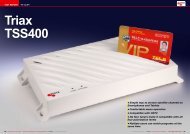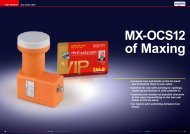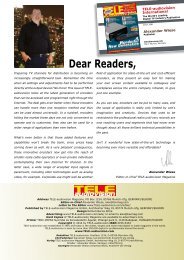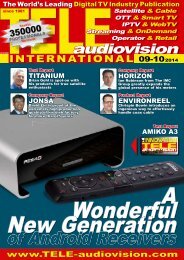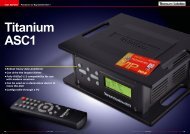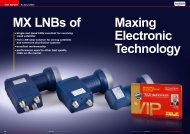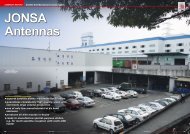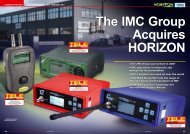eng TELE-audiovision 1411
The World’s Largest Digital TV Trade Magazine
The World’s Largest Digital TV Trade Magazine
You also want an ePaper? Increase the reach of your titles
YUMPU automatically turns print PDFs into web optimized ePapers that Google loves.
that meet precise requirements without<br />
technicians having to familiarise themselves<br />
with new control interfaces for<br />
each device.<br />
All used encoders are compatible with<br />
H.264 (MPEG-4 Part 10 AVC according<br />
to ISO / IEC 14496-10) and can create<br />
streams with either CBR (constant bit<br />
rate) or VBR (variable bit rate), depending<br />
on the configuration of the device.<br />
MPEG-4 Part 10 can easily be called the<br />
most popular format for video compression<br />
today and has become the<br />
established standard for recording and<br />
distributing video content.<br />
For our in-depth test the CW-4412<br />
variant was shipped to the <strong>TELE</strong>-<strong>audiovision</strong><br />
Test Center. The device is packaged<br />
inside a sturdy cardboard, which<br />
makes sure it arrives at its destination<br />
in mint condition. Apart from the encoder<br />
itself and the power cable there<br />
were only two sheets of paper inside<br />
the box: One contained the operating<br />
manual in English, the other one featured<br />
instructions for the web interface.<br />
Both texts are rather concise and<br />
only provide essential steps for operation:<br />
The CW-4412 can either be controlled<br />
via Windows software or directly<br />
through its web interface from any web<br />
browser. The default IP addresses for<br />
accessing the encoder are also given in<br />
the instructions.<br />
With its white rack-sized case the<br />
CW-4412 looks just as unpretentious as<br />
the instruction manual: The only physical<br />
control element is an On/Off switch<br />
on the back panel of the encoder. What<br />
the back panel does feature, however,<br />
is an abundance of connection options.<br />
Owing to the fact that the CW-4412 is<br />
capable of simultaneously compressing<br />
two independent input signals into the<br />
MPEG-4 format we have two connection<br />
interfaces each for SDI, component<br />
video (YUV), composite video and<br />
HDMI. As far as outputs are concerned<br />
this encoder sports a total of four ASI<br />
outputs, which means there are two<br />
ASI sockets for each of the two encoders.<br />
Two USB ports – again, one for<br />
each encoder – are available for firmware<br />
updates.<br />
Turning to the front panel, we find 10<br />
LEDs which indicate the encoders’ current<br />
operating mode. Divided into three<br />
sections, 4 LEDs on the left refer to<br />
encoder 1 (Input 1, BUSY, HD and ER-<br />
ROR), 4 LEDs on the right do the same<br />
for encoder 2, while the middle section<br />
indicates the following general states:<br />
LINK, ACT, PWR and FIBER.<br />
1<br />
With the clear labelling of those LEDs,<br />
their purpose is more or less self-explanatory:<br />
INPUT 1 and INPUT 2: These two<br />
LEDs indicate whether or not a signal is<br />
fed into the encoders.<br />
BUSY: A slowly flashing LED indicates<br />
that new firmware is being loaded.<br />
If the LED flashes in short intervals,<br />
this indicates that process parameters<br />
are loaded by the computer. In both<br />
cases the MPEG-4 compression routine<br />
is temporarily stopped. In general,<br />
however, such interruptions do not last<br />
longer than 1 or 2 seconds.<br />
HD: Lights up whenever an HD signal<br />
is available from the encoder input.<br />
ERROR: In case an error occurs during<br />
the encoding process this LED will<br />
light up. This can happen if the process<br />
SW-4412<br />
1. This application allows to configure the<br />
input signal on the CW-4412 encoder. You<br />
can convert high resolution signals to<br />
lower resolution signals. Also, it is possible<br />
to select if a constant bit rate (CBR) or a<br />
variable bit rate (VBR) should be used. The<br />
latter can be used to decrease the summed<br />
bit rate of a transport stream containing<br />
many channels: in average different channels<br />
rarely have high bit rate requirements<br />
in the same moment in time, which helps<br />
keeping the overall transport stream bit<br />
rate low. To use the VBR option, different<br />
interdependent parameters have to be<br />
specified. Fortunately, the CW-4412 will let<br />
you know instantly if they make sense and<br />
suggest how to calculate correct values –<br />
this will help you save the time of digging<br />
out reference manuals. Another important<br />
set of configurable parameters that include<br />
the Service Provider and Service Name and<br />
the allocated Video, Audio, PMT, PCR, TS<br />
and TXT PID’s.<br />
2. Clicking on the MPEG Encoder -2 tab will<br />
simply open the exact same set of parameters<br />
for the second encoder of the CW-4412.<br />
In fact, the CW-4412 acts as two independent<br />
MPEG-4 encoders, which just happen<br />
to share the same case, power supply and<br />
operational frontend.<br />
2<br />
18 <strong>TELE</strong>-<strong>audiovision</strong> International — The World‘s Leading Digital TV Industry Publication — 11-12/2014 — www.<strong>TELE</strong>-<strong>audiovision</strong>.com





